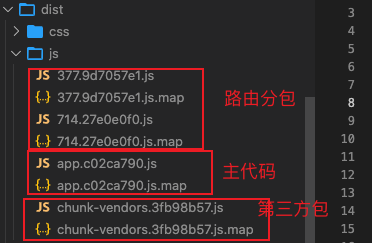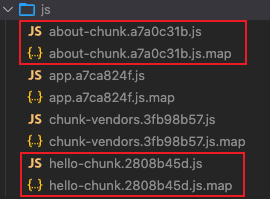vue-router的安装,{path,component,children,meta,redirect},router-link,router-view,动态路由,导航守卫
1. 认识前端路由
路由其实是网络工程中的一个术语
- 在架构一个网络时,非常重要的两个设备就是
路由器和交换机 - 当然,目前在生活中路由器也是越来越被大家所熟知,因为生活中都会用到路由器
- 事实上,路由器主要维护的是一个映射表;
映射表会决定数据的流向;
- 在架构一个网络时,非常重要的两个设备就是
路由的概念在软件工程中出现,最早是在后端路由中实现的,原因是web的发展主要经历了这样一些阶段:
- 后端路由阶段;
- 前后端分离阶段;
- 单页面富应用(SPA);
1.1. 后端路由阶段
早期的网站开发整个HTML页面是由服务器来渲染的
- 服务器直接生产渲染好对应的HTML页面, 返回给客户端进行展示.
但是, 一个网站,这么多页面服务器如何处理呢?
- 一个页面有自己对应的网址, 也就是URL;
- URL会发送到服务器, 服务器会通过正则对该URL进行匹配, 并且最后交给一个Controller进行处理;
- Controller进行各种处理, 最终生成HTML或者数据, 返回给前端.
上面的这种操作, 就是后端路由:
- 当页面中需要请求不同的路径内容时, 交给服务器来进行处理, 服务器渲染好整个页面, 并且将页面返回给客户端.
- 这种情况下渲染好的页面, 不需要单独加载任何的js和css, 可以直接交给浏览器展示, 这样也有利于SEO的优化.
后端路由的缺点:
- 一种情况是整个页面的模块由后端人员来编写和维护的;
- 另一种情况是前端开发人员如果要开发页面, 需要通过PHP和Java等语言来编写页面代码;
- 而且通常情况下HTML代码和数据以及对应的逻辑会混在一起, 编写和维护都是非常糟糕的事情;
1.2. 前后端分离阶段
前端渲染的理解:
- 每次请求涉及到的静态资源都会从静态资源服务器获取,这些资源包括HTML+CSS+JS,然后在前端对这些请求回来的资源进行渲染;
- 需要注意的是,客户端的每一次请求,都会从静态资源服务器请求文件;
- 同时可以看到,和之前的后端路由不同,这时后端只是负责提供API了;
前后端分离阶段:
- 随着Ajax的出现, 有了前后端分离的开发模式;
- 后端只提供API来返回数据,前端通过Ajax获取数据,并且可以通过JavaScript将数据渲染到页面中;
- 这样做最大的优点就是前后端责任的清晰,后端专注于数据上,前端专注于交互和可视化上;
- 并且当移动端(iOS/Android)出现后,后端不需要进行任何处理,依然使用之前的一套API即可;
- 目前比较少的网站采用这种模式开发(jQuery开发模式);
1.2.1. URL的hash
前端路由是如何做到URL和内容进行映射呢?
监听URL的改变URL的hash
- URL的hash也就是锚点(#), 本质上是改变
window.location的href属性; - 可以通过直接赋值location.hash来改变href, 但是
页面不发生刷新;
- URL的hash也就是锚点(#), 本质上是改变
hash的优势就是兼容性更好,在老版IE中都可以运行,但是缺陷是有一个#,显得不像一个真实的路径
1 |
|
1.2.2. HTML5的History
- history接口是HTML5新增的, 它有l六种模式改变URL而不刷新页面:
- replaceState:替换原来的路径;
- pushState:使用新的路径;
- popState:路径的回退;
- go:向前或向后改变路径;
- forward:向前改变路径;
- back:向后改变路径;
1 |
|
2. 认识vue-router
目前前端流行的三大框架, 都有自己的路由实现:
- Angular的ngRouter
- React的ReactRouter
- Vue的vue-router
Vue Router 是 Vue.js 的官方路由。它与 Vue.js 核心深度集成,让用 Vue.js 构建单页应用变得非常容易。
- 目前Vue路由最新的版本是4.x版本,我们上课会基于最新的版本讲解。
vue-router是基于路由和组件的
- 路由用于设定访问路径, 将路径和组件映射起来
- 在vue-router的单页面应用中, 页面的路径的改变就是组件的切换.
安装Vue Router:
1
npm install vue-router
2.1. 路由的使用步骤
- 使用vue-router的步骤:
- 第一步:创建路由组件的组件;
- 第二步:配置路由映射: 组件和路径映射关系的routes数组;
- 第三步:通过createRouter创建路由对象,并且传入routes和history模式;
- 第四步:使用路由 - 通过
<router-link>和<router-view>;
2.1.1. Hello.vue
放在 src/components文件夹中
1 | <template> |
2.1.2. About.vue
放在 src/components文件夹中
1 | <template> |
2.1.3. router/index.js
1 | import { createRouter, createWebHashHistory, createWebHistory } from 'vue-router'; |
2.1.4. main.js
引入 router/index.js
1 | import { createApp } from 'vue' |
2.1.5. App.vue
使用路由
1 | <template> |
2.2. 路由的默认路径
还有一个不太好的实现:
- 默认情况下, 进入网站的首页,希望
<router-view>渲染首页的内容; - 但是在实现中, 默认没有显示首页组件, 必须让用户点击才可以;
- 默认情况下, 进入网站的首页,希望
如何可以让路径默认跳到到首页, 并且
<router-view>渲染首页组件呢?在routes中又配置了一个映射:
path配置的是根路径: /
redirect是重定向, 也就是将根路径重定向到/home的路径下, 这样就可以得到想要的结果
1 | const routes = [ |
2.3. history模式
选择不同的history模式
1 | import { createRouter, createWebHashHistory, createWebHistory } from 'vue-router'; |
- createWebHashHistory 导致的路由效果是 http://localhost:8080/#/
- createWebHistory 导致的路由效果是 http://localhost:8080
2.4. 路由的其他属性
- name属性:路由记录独一无二的名称;
- meta属性:自定义的数据
1 | { path: '/hello', |
3. 路由懒加载
当打包构建应用时,JavaScript 包会变得非常大,影响页面加载:
- 如果把不同路由对应的组件分割成不同的代码块,然后当路由被访问的时候才加载对应组件,这样就会更加高效;
- 也可以提高首屏的渲染效率;
其实涉及的是webpack的分包知识,而Vue Router默认就支持动态来导入组件:
- 这是因为component可以传入一个组件,也可以接收一个函数,该函数需要放回一个Promise;
- 而import函数就是返回一个Promise;
1 | const routes = [ |
4. 打包效果分析
分包是没有一个很明确的名称的,其实webpack从3.x开始支持对分包进行命名(chunk name):

进行打包命名
1 | const routes = [ |
重新打包

5. 动态路由
5.1. 动态路由基本匹配
将给定匹配模式的路由映射到同一个组件:
例如,有一个 User 组件,它对所有用户进行渲染,但是用户的ID是不同的;
在Vue Router中,在路径中使用一个动态字段来实现,称之为
路径参数;1
2
3
4{
path: '/user/:id',
component: ()=> import('../components/User.vue')
}
在router-link中进行如下跳转:
1
<router-link to="/user/123">用户:123</router-link>
5.2. 获取动态路由的值
在template中,直接通过
$route.params获取值;在created中,通过
this.$route.params获取值;在setup中,使用 vue-router库提供的一个hook
useRoute;- 该Hook会返回一个Route对象,对象中保存着当前路由相关的值;
1 | <template> |
5.3. 匹配多个参数
1 | { |
获取参数值
1 | export default { |
结果
1 | {id: '001', name: 'john'} |
5.4. NotFound
对于哪些没有匹配到的路由,通常会匹配到固定的某个页面
比如NotFound的错误页面中,可编写一个动态路由用于匹配所有的页面;
1
2
3
4{
path: '/:pathMatch(.*)',
component: ()=> import('../components/NotFound.vue')
}可以通过
$route.params.pathMatch获取到传入的参数:1
2
3
4
5<template>
<div>
<h2>Not Found {{$route.params.pathMatch}}</h2>
</div>
</template>当访问
http://localhost:8080/1时,
5.5. 匹配规则加 *
在/:pathMatch(.*)后面又加了一个 *
1 | { |
区别在于解析的时候,是否解析 /:
对于http://localhost:8080/1/2/3
| 使用规则 | /:pathMatch(.*) |
/:pathMatch(.*)* |
|---|---|---|
| 显示结果 | Not Found 1/2/3 | Not Found [ “1”, “2”, “3” ] |
6. 路由的嵌套
- 什么是路由的嵌套呢?
- Hello、About、User等都属于底层路由,在它们之间可以来回进行切换;
- 但是 Hello 页面本身,也可能会在多个组件之间来回切换:
- 比如 Hello 中包括 Product、Message,它们可以在Hello 内部来回切换;
- 这个时候就需要使用嵌套路由,在 Hello 中也使用
router-view来占位之后需要渲染的组件;
6.1. 嵌套配置
首先需要创建 HelloProduct.vue,HelloMessage.vue
1 | { path: '/hello', |
在 Hello.vue 中编写路由
1 | <template> |
6.2. 代码的页面跳转
通过代码来完成页面的跳转,比如点击的是一个按钮
1
<button @click="$router.push('/hello/product')">Product</button>
或者使用methods
1
2
3
4
5methods: {
jumpToRouter(){
this.$router.push("/hello/message")
}
}也可以传入一个对象
1
2
3
4
5jumpToRouter(){
this.$router.push({
path: '/hello/message'
})
}如果是在setup中编写的代码,可以通过 useRouter 来获取
1 | import { useRouter } from 'vue-router'; |
6.3. query方式的参数
通过query的方式来传递参数
1
2
3
4
5
6
7
8
9jumpToRouter(){
this.$router.push({
path: '/hello/message',
query: {
name: 'john',
age: 18
}
})
}通过 $route.query 来获取参数
1
2
3
4<p>
{{$route.query.name}}
{{$route.query.age}}
</p>
6.4. 页面的前进后退
router的go方法:
1
2
3
4
5
6
7
8
9
10
11const go = ()=>{
// 向前移动一条记录,与 router.forward()相同
router.go(1);
// 返回一条记录,与 router.back()相同
router.go(-1);
// 前进3条记录
// 如果没有那么多记录,静默失败
router.go(30);
}router也有back:
- 通过调用 history.back() 回溯历史
- 相当于 router.go(-1);
router也有forward:
- 通过调用 history.forward() 在历史中前进
- 相当于 router.go(1);
7. router-link
7.1. to属性
- 是一个字符串,或者是一个对象
- 等价于 a标签的 href 属性
7.2. replace
- 替换当前的位置
- 使用push的特点是压入一个新的页面,那么在用户点击返回时,上一个页面还可以回退,但是如果希望当前页面是一个替换操作,那么可以使用replace
| 声明式 | 编程式 |
|---|---|
<router-link to="..." replace> |
router.replace(...) |
7.3. active-class,exact-active-class
对于 router-link 中的样式匹配问题:
active-class属性:
- 设置激活a元素后应用的class,默认是router-link-active
- /hello 会匹配
- /hello/product 也会匹配
exact-active-class属性:
- 链接
精准激活时,应用于渲染的<a>的 class,默认是router-link-exact-active; - /hello 不会匹配
- /hello/product 才会匹配
- 链接
7.4. v-slot
- 在vue-router3.x的时候,router-link有一个tag属性,可以决定router-link到底渲染成什么元素:
- 但是在vue-router4.x开始,该属性被移除了;
- 而提供了更加具有灵活性的v-slot的方式来定制渲染的内容;
7.4.1. 使用
1 | <router-link to="/about" v-slot="props"> |
结果
1 | { |
7.4.2. props
使用v-slot来作用域插槽来获取内部传的值:
- href:解析后的 URL;
- route:解析后的规范化的route对象;
- navigate:触发导航的函数;
- isActive:是否匹配的状态;
- isExactActive:是否是精准匹配的状态;
7.4.3. custom
使用
custom表示整个元素要自定义如果不写,那么自定义的内容会被
包裹在一个 a 元素中;如果写了,自定义内容就不会拥有路由功能,需要指定
props.navigate1
2
3
4
5<router-link to="/about" active-class="active" v-slot="props" custom>
<p @click="props.navigate">
{{props.href}}
</p>
</router-link>
7.4.4. router-view
- router-view也提供一个插槽,可以用于
<transition>和<keep-alive>组件来包裹路由组件- Component:要渲染的组件;
- route:解析出的标准化路由对象;
1 | <router-view v-slot="props"> |
8. 操作路由
8.1. 动态添加路由
某些情况下可能需要动态的来添加路由
- 比如根据用户不同的权限,注册不同的路由;
- 可以使用一个方法 addRoute;
1
2
3
4
5
6
7
8
9
10
11
12
13
14
15
16
17
18
19
20import { createRouter, createWebHistory } from 'vue-router';
// 不同角色,不同访问路由
const routes = [];
const router = createRouter({
routers,
history: createWebHistory()
});
if(管理员){
router.addRoute({
path: '/about',
name: 'about',
component: ()=> import('../components/About.vue')
});
}
else{
router.removeRoute('about');
}如果是为route添加一个children路由,那么可以传入对应的name
- 此时可以访问
/hello/home
1
2
3
4
5
6
7const HomeRoute = {
path: 'home', component: ()=> import(
/* webpackChunkName:"home-chunk"*/
'../components/Home.vue')
}
router.addRoute('hello',HomeRoute);- 此时可以访问
8.2. 动态删除路由
- 删除路由有以下三种方式
- 添加一个name相同的路由;
- 通过removeRoute方法,传入路由的名称;
- 通过addRoute方法的返回值回调;
1 | const about = router.addRoute({ |
8.3. 检查路由是否存在
router.hasRoute()
8.4. 所有路由数组
router.getRoutes()
1 | [ |
9. 路由导航守卫
9.1. 基本使用
vue-router 提供的导航守卫主要用来通过跳转或取消的方式守卫导航
全局的前置守卫beforeEach是在导航触发时会被回调的
它有两个参数:
- to:即将进入的路由Route对象;
- from:即将离开的路由Route对象;
它有返回值:
- false:取消当前导航;
- 不返回或者undefined:进行默认导航;
- 返回一个路由地址
- 可以是一个string类型的路径;
- 可以是一个对象,对象中包含path、query、params等信息;
可选的第三个参数:next
- 在Vue2中我们是通过next函数来决定如何进行跳转的;
- 但是在Vue3中通过返回值来控制的,不再推荐使用next函数,这是因为开发中很容易调用多次next;
1 | router.beforeEach((to,from)=>{ |
9.2. 登录守卫功能
完成一个功能,只有登录后才能看到其他页面
router/index.js
1 | router.addRoute({ |
Login.vue:模拟注册token
1 | <template> |
9.3. 其他导航守卫
- Vue还提供了很多的其他守卫函数,目的都是在某一个时刻给予回调,可以更好的控制程序的流程或者功能:
9.4. 完整的导航解析流程
- 导航被触发。
- 在失活的组件里调用
beforeRouteLeave守卫。 - 调用全局的
beforeEach守卫。 - 在重用的组件里调用
beforeRouteUpdate守卫(2.2+)。 - 在路由配置里调用
beforeEnter。 - 解析异步路由组件。
- 在被激活的组件里调用
beforeRouteEnter。 - 调用全局的
beforeResolve守卫(2.5+)。 - 导航被确认。
- 调用全局的
afterEach钩子。 - 触发 DOM 更新。
- 调用
beforeRouteEnter守卫中传给next的回调函数,创建好的组件实例会作为回调函数的参数传入。